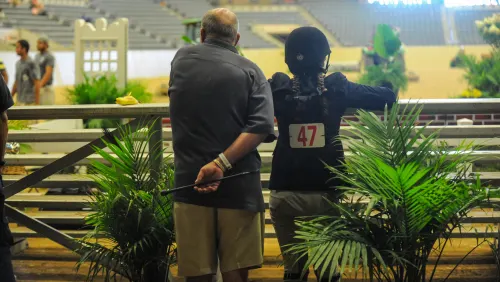In this week’s Stallion Issue, we’re welcoming our newest columnist, Scott Hassler, since he’ll be writing about sport horse breeding. Scott is the head trainer at Hilltop Farm in Colora, Md., one of our country’s most commercially successful sport horse breeding operations. His valuable advice to breeders about appraising their stock coincides with our lead article, in which staff member Sara Lieser consults a variety of breeders on how to turn a profit.
As you’ll see, though, there isn’t a silver bullet or time-tested guarantee. The key is to produce horses that people want to buy, and a goal of the USEF Breeders’ Committee is to help breeders do just that. So before I wrote this Commentary, I had a long talk with Hallie McEvoy, a Thoroughbred and sport horse breeder from Vermont who became the committee’s vice chairman early this year. She admitted, “We’ve got a lot to do, and it’s not going to happen overnight.”
I suggested to her that their daunting task reminded me of the joke, “How do you eat an elephant? One bite at a time.” Hallie said she wondered whether they should start at the front or the back.
ADVERTISEMENT
The big question for any breeder, as Scott points out, is what kind of horses are they trying to produce, international performers for elite riders or rideable, enjoyable, trustworthy mounts for anyone? No matter which way a breeder answers, Hallie would like the USEF’s database to be able to produce comprehensive performance and pedigree records that would help them make more informed mating decisions. But the committee first needs to determine what performance characteristics they want to quantify, and that’s a tough philosophic and practical question to answer. Should every competitive placing receive points? Weight placings according to class size, show rating, prize money or other factors? Average score for dressage? Is an adult amateur championship at a local member show more valuable than a green conformation championship at Washington?
So Hallie, committee chairman Gareth Selwood (who stands Andalusian and Friesian stallions in Wisconsin) and the other 14 committee members are taking a close look at the numerous state Thoroughbred incentive programs, as well as those of dozens of breed associations, to see if they can adapt anything for their use. One plan Hallie would like to implement would reward the breeder (financially or otherwise) every time a horse they bred wins or places in a competition. But before such a far-reaching plan can take shape, Hallie believes they have to affect an attitudinal shift among American horse owners. They have to convince American riders and drivers to care about the relationship between pedigree and performance and to buy American. But she fully realizes that American breeders have to give them a reason to do either. “We’ve got to be offering a product that’s winning in the show ring–or at least a horse that they will enjoy. And one of the beauties of America is that we can offer horses of all these ranges,” she said.
But horse breeders can be an extremely contentious group, and over the last two decades a long line of ideas and programs have foundered in a caldron of contention or rivalry between breeders and breed groups. Consequently, committee and association leaders are always anxious about sticking their necks out for breeding-related programs, afraid it might not please everyone. What U.S. breeders really need to do is rally behind some brave, visionary leaders, some people who can grab a whip and an elephant hook to start leading the wandering elephant that is U.S. breeding toward its destination.














